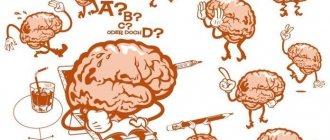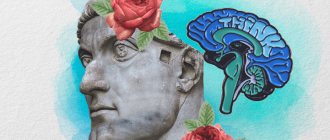Hello, hello, dear blog visitors! Lyudmila Redkina is with you. Have you ever considered phenomenal memory to be quackery? Not long ago I watched the program “Coolest of All,” where little children memorized the number Pi, guessed cells with different numbers, and solved a huge number of examples in a split second! It's hard to believe, but it's still possible! Oh, an interesting topic awaits us today - let’s talk about what mnemonics are for developing the memory of adults, I’ll tell you about 7 exercises that will help you remember a lot of information in a limited time.
Basic mnemonic devices
One of the most famous mnemonic devices is the acrostic poem. It is a poem or phrase where the first letters of each word or line form the key information to be remembered.
Since childhood, we have been familiar with the simple phrase “Every Hunter Wants to Know Where the Pheasant Sits.” This is how we remembered what colors the rainbow consists of and in what order they are located.
My grandmother taught me to easily remember the number of days in each month using my knuckles. And this is also mnemonics.
There are other interesting ways to remember. Let's start with basic techniques for adults.
Alphanumeric code
This method will help you remember your phone number, car number, house number, date of birth or any other number. Its essence is that we need to replace the numbers with the letters with which the names of the numbers begin.
See:
- 0 – zero – N;
- 1 – times – P;
- 2 – two – D;
- 3 – three – T;
- 4 – four – H;
- 5 – five – P;
- 6 – six – Ш;
- 7 – seven – C;
- 8 – eight – B;
- 9 – a lot – M (since we already have D under the number 2, nine is usually denoted by the word “many” and the letter M).
To make it easier to convert numbers into alphabetic codes, you need to learn these notations like a multiplication table. Then the encoding will pop up in your head automatically.
Let's try to encrypt the date of birth in this way. For example, December 25th.
The rule is this: the first number in the code is the first consonant letter in the word, the second number is the second consonant letter of this word. We will encrypt the next two digits into the second word using a similar principle.
So, we need to come up with the first word with the letters D and P. For example, DePo. The second word should contain the letters R and D. Let it be the word “Radio”. The result was a bunch of “DePo Radio”. If you need a more meaningful phrase to remember, you can make up the phrase “Radio played at DePauw.”
More than 100 cool lessons, tests and exercises for brain development
Start developing
I think you understand the principle.
Associations
Consider the “Hanger” technique. Its essence is that in order to remember a word, name, digital value, we need to attach an association to it.
For example, in order to easily remember various digital combinations, we need to create our own association for each number. Each person may have their own associations.
Below in the picture you can see associations that are often used in psychological tests.
What other “hangers” can you come up with for each number:
- 1 – candle, straw, pencil;
- 2 – snake, swan;
- 3 – seagull, camel humps;
- 4 – sailboat, flag;
- 5 – palm, seahorse;
- 6 – snail, bag;
- 7 – scythe, boomerang;
- 8 – snowman, hourglass;
- 9 – umbrella, watering can;
- 0 – saucer, sun.
The main thing is to choose a single scale of associations for yourself and use only that one. Otherwise you will get even more confused.
Let's encrypt the number 48 using the values from the picture as a basis. Imagine glasses lying on a chair and say: “I am sitting on a chair and looking for glasses.”
The association method can also be used when remembering names. For example, you just can’t remember the name of history teacher Daniil Lvovich. The name can be associated, for example, with the famous actor Danila Kozlovsky. And associate the middle name with the main predator of the savannah - the lion.
To remember a surname, it can also be linked to an association. For example, Shishkin is a fir cone or the famous artist of a painting with three bears in the forest. Borodachev is a man with a long beard. And so on.
Rhymes
With rhyme, everything is easier to remember. Remember the school rhyme with exception verbs?
Shave, lay, look, offend,
Hear, see, hate,
Drive, breathe, hold, twirl,
And depend and endure.
Or this one:
A bisector is a rat that runs around the corners and divides the corner in half.
You can rhyme anything: shopping lists, names of colleagues and even phone numbers. Here is an example of a poem for a housewife who is going to the store:
Cheese, sour cream and cottage cheese,
Glazed curd.
Brought from afar
Three cans of milk,
Bread, sausages and cabbage,
So that the house is thick.
And in order to remember numbers, you need to assign certain rhymes to them. Below I will give examples, and your task is to choose one word at a time and memorize them, so that you can quickly apply them in your quatrains.
You can use the following rhymes:
- zero – moth, crawl, password, permission, beans, console;
- one - master, middle, aspen, half;
- two – head, words, grass, tops;
- three - bubbles, jury, crackers, bet, collect, from dawn;
- four - in the apartment, in the world, wider, on the air;
- five – say, bed, break, walk, understand;
- six - honor, tin, not to count, eat, father-in-law;
- seven – schemes, helmet, darkness, eat;
- eight - we ask, autumn, wear, earth, freeze;
- nine - do, winnow, brother-in-law, left.
Consonance
This technique is useful when learning foreign words that are simply difficult to remember. Many English words are consonant with Russian words.
The word look in translation means “to look” and its sound resembles the Russian word “onion”. You can remember the translation like this: when we peel onions, our eyes begin to water and it is difficult for us to look.
Another example. The phrase living room is translated as “living room”. The first word is consonant with our “rain”. You can imagine the following situation: it’s raining outside, we have to sit in a warm living room.
The word competitor is similar to “composer” and is translated as “rival, competitor.” Imagine two competing composers vying for the title of author of the best piece of music. And so on.
Here's another good mnemonic way to learn foreign languages. It will help you master free communication without being tied to translation. For example, you need to quickly memorize the word cup. Your task is to immediately initiate its association in your head. To do this, pick up a cup and say the word cup several times.
Exactly the same with other words. If it does not represent an object or is not at hand, simply recreate the meaning of this word in your imagination and say it several times.
Repetitions
Scientists have managed to identify the optimal pattern that helps you learn anything. If you have to remember text, phone numbers, poetry or any other information, learn it in several approaches:
- Studying.
- Repeat after 15–20 minutes.
- Next repetition after 6–8 hours.
- Another repetition in a day.
You can learn more about memory and attention training in adults in our separate article.
How it works?
The work of mnemonics consists of five stages:
- Abstract data is taken;
- Encoding occurs - connections are created between them;
- Repetition, memorization in a convenient form;
- Information decoding, decoding;
- Reproduction of the necessary information that needed to be remembered.
At first glance, the scheme seems complicated and lengthy. In fact, you choose any technique that is convenient for you. And with time and experience, the process of memorization becomes easier, it becomes like a game.
Exercises for children and teenagers
Until the age of 14, a child develops abstract logical thinking and remembers best what he personally experiences. Mnemonics allows you to connect associations from life experience with abstract concepts from the curriculum. Thus, the process of memorization and learning as a whole is simplified.
Next, we will look at the most accessible and effective methods.
Story method
This technique is suitable when a child needs to remember a series of words that are absolutely unrelated to each other. To do this, you should imagine their meanings in your imagination and come up with a story using them. The funnier or more fantastic the story, the simpler and better it will be remembered. The technique is suitable even for younger schoolchildren.
Let's look at an example. Let's take a list of words:
- Bee.
- Rain.
- Sofa.
- Pan.
- Borsch.
- Tulip.
- Postman.
- Tiger.
- Corn.
- Toothbrush.
Let's try to invent a story with these words.
Postman Pechkin rode on a tiger through a corn field. Out of nowhere a swarm of bees , but then it started to rain and dispersed them all. The rain was magical, and instead of corn, tulips . Then Pechkin noticed a tent in the middle of the field. a sofa in it , and borscht in the stove . And sticking out of it was not a ladle, but a toothbrush .
In this way, you can compose a story from a list of products, names of school subjects, plans for the weekend, etc.
Chain method
The task is to combine several images into a single chain. It is important to ensure that all words are consistent.
For example, let's take the following words: horse, daisies, sandwich, chess, history, chimpanzee. Let's see how you can create a chain from them.
The horse , bathing in the grass with daisies , chewed a sandwich and watched how and chimpanzees taught history chess .
As you can see, words are strung onto a sentence like beads on a string. It is enough to remember the first word. The rest will follow on their own.
Cicero's method
Other common names for this technique are “Roman Room Method” and “Mnemonic Room”. Why, exactly, Cicero? This ancient Roman politician and orator never used cheat sheets and could reproduce many quotes, facts, names and historical dates from memory.
When Cicero prepared for speeches, he walked around the house and mentally placed the key points of his speech on each object.
So, the essence of the method:
- You need to choose a room. This could be a room in your apartment or an auditorium where you are planning a performance.
- Then you need to attach a unit of information to each item: a keyword, a sentence or a whole thought. It is better to do this by moving your gaze clockwise. This will make it easier to remember.
- During the performance, it is enough to remember the situation in the rehearsal room. The necessary information will emerge in memory by itself.
More and more new images can be attached to the same location. But from time to time it is better to change the room so that the information does not get confused.
This technique can use not only rooms, but also the road from home to school, for example. Pay attention to what you see: a bench, an urn, a lantern, a store, three birch trees, a gate, a flowerbed, etc. Attach images from the information you remember to each object, and during the story, recreate the entire path in your memory.
Features of application
You can achieve results during mnemonics classes if you follow the basic rules for using the technique.
- Subsequence. You cannot start classes with difficult tasks. First they work with mnemonic squares, single images, then with mnemonic tracks and mnemonic tables.
- Rationing. Children are not shown more than two tables per day, and the number of images in each block should be no more than 9 pieces. Too much information is difficult for a child to absorb, so classes will be ineffective.
- Colorfulness. The pictures should interest the child in their appearance. They use bright colors, rich and expressive images. Tables in black and white will not be able to attract the attention of children and have the desired impact; they can only be used for children of older preschool age.
- Emotionality. Children should feel the positive energy of such activities.
- Diversity. Pictures or series of images for one lesson should be on different topics. Guys will quickly lose interest in the same type of training. It is also advisable to select tables that require different actions. For example, the first pictures help to remember the sequence of food intake, and the next group helps to tell about how insects move.
- No coercive measures: just a game. Classes can only be conducted when children are involved in the process with pleasure and interest. Everything should happen in a playful way. If the children's attention wanes, it is better to stop the lesson and continue at another time.
It is enough to adhere to these simple principles to achieve maximum learning results.
Courses and simulators on mnemonics
Nowadays you can find a lot of different training services and courses on memory development on the Internet. I have chosen the most famous and successful ones to make your search easier.
Mnemonics – 4brain
Mnemonics is an online program from the 4brain intellectual club. It lasts 5 weeks and consists of 16 lessons. It is very convenient to absorb information, since only 20–30 minutes are allotted for each lesson.
You will learn to quickly and easily remember:
- dates and events;
- names and faces of people;
- any numbers and phone numbers;
- to-do and shopping lists;
- foreign and other unfamiliar words;
- poems.
In addition to new skills, you will receive:
- Summary with useful notes and links.
- Personal progress statistics.
- Diploma from the platform.
The cost of participation with a discount is 1,990 rubles.
Mnemonics – Wikium
Mnemonics - a course from a popular platform with brain simulators. It includes:
- 7 unique online simulators;
- memory development program;
- a ready-made set of key techniques for easy memorization;
- tests.
You will learn:
- remember all passwords and codes;
- congratulate loved ones on their birthday without delay;
- instantly memorize poems;
- keep all agreements in mind;
- memorize mobile phone numbers by ear.
With a discount, the course costs 990 rubles.
Mnemonics: how to easily remember information for grades 5–11 - Foxford
The course Mnemonics: how to easily remember information for grades 5–11 can now be viewed in the recording. There are 12 lessons in total. They consist of theory, webinars and homework. The program will be useful for middle and high school students, as well as anyone who wants to improve their memory.
In this class you will learn how to memorize:
- formulas;
- names;
- faces;
- poetry;
- any digital data;
- foreign words.
The cost of the course is 2,990 rubles. Installment plan available. To understand how the course works, you can watch the introductory lesson for free.
Rhyming
There are techniques for memorizing through sound. For example, it is easier to remember some complex rule or law of physics with the help of a funny rhyme: “A body pressed into water bulges out with the force of the water pushed out by the body pressed there,” this is how Archimedes’ law sounds. It’s definitely easier to learn, and you’ll remember such jokes for a long time.
Or, for example, when studying foreign languages. Many foreign words are consonant with Russian ones and this can be taken advantage of by creating associative connections. For example, the French verb travailler means "to work." It sounds similar to our Russian word “tram”. The tram moves along given rails, this can easily be associated with the meaning of “work”. Or the sound of the French “travaille” is close to the word “labor”. That's how it will be remembered.
Using these popular and simple memorization methods, you can learn languages, exact sciences, and remember large amounts of information. An excellent memory saves time, energy and helps you be more successful and erudite.
The best books on mnemonics
Finally, a small selection of useful books on the topic:
- Joshua Foer “Einstein Walks on the Moon. The Science and Art of Memory"
- Boris Nikolai Konrad “How to remember everything! Secrets of the world champion in mnemonics”
- Anton Moguchiy “The most complete training book for brain development! New trainings for the mind”
- Ilya Melnikov “The best ways to remember”
- Stanislav Muller “Remember everything: secrets of supermemory. Book-simulator”
- Anton Moguchiy “Use your brain 100%! Book-simulator for the development of the mind and memory”
Even more books for memory development can be found in our separate publication.
Memorization example
The following is an example of using Cicero's method. You need to remember the shopping list: bread, milk, butter, kefir, chicken. On the way to the store there is a football club for preschoolers, a stop, a pedestrian crossing, an underground passage, and a cinema.
You can imagine, instead of the roof of the club, there is a loaf of bread, that on a bus stop bench there is a large package of milk, on a pedestrian crossing there is a block of butter the size of a house, at the entrance to the underground passage there is a package of kefir, and a giant chicken is attached to the door of the cinema.
Mnemonic information structure
Thus, mnemonics is memory training and increasing its potential, which can be carried out with different age categories. There are children's mnemonics that are suitable for preschoolers or children of primary school age. There is also an adult variation. It’s easy to learn: you can master these techniques yourself or take a course in this discipline.











